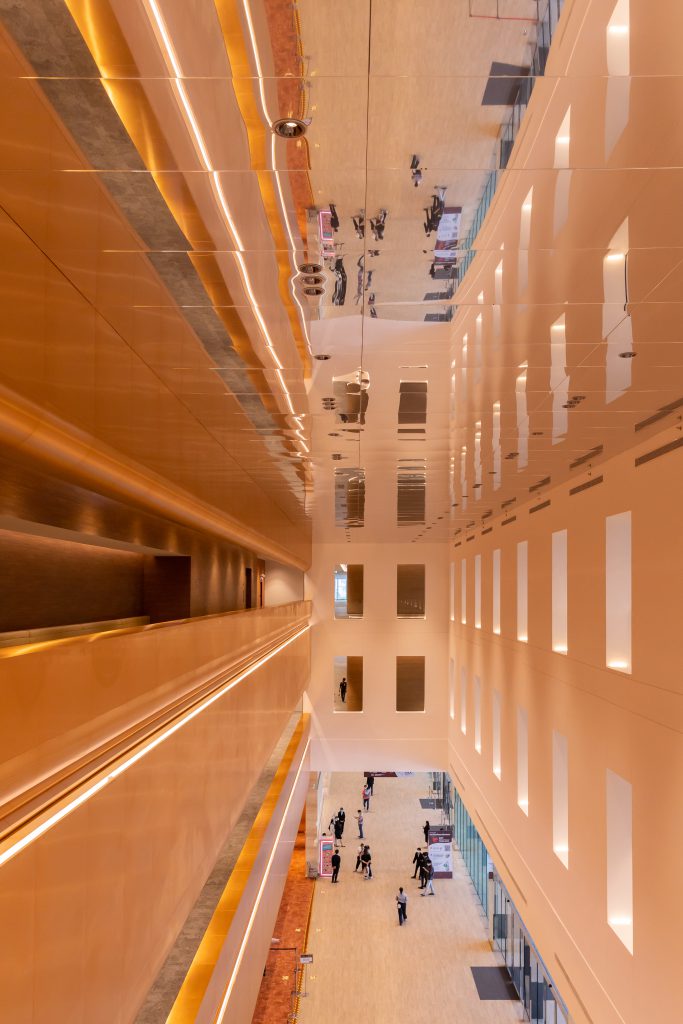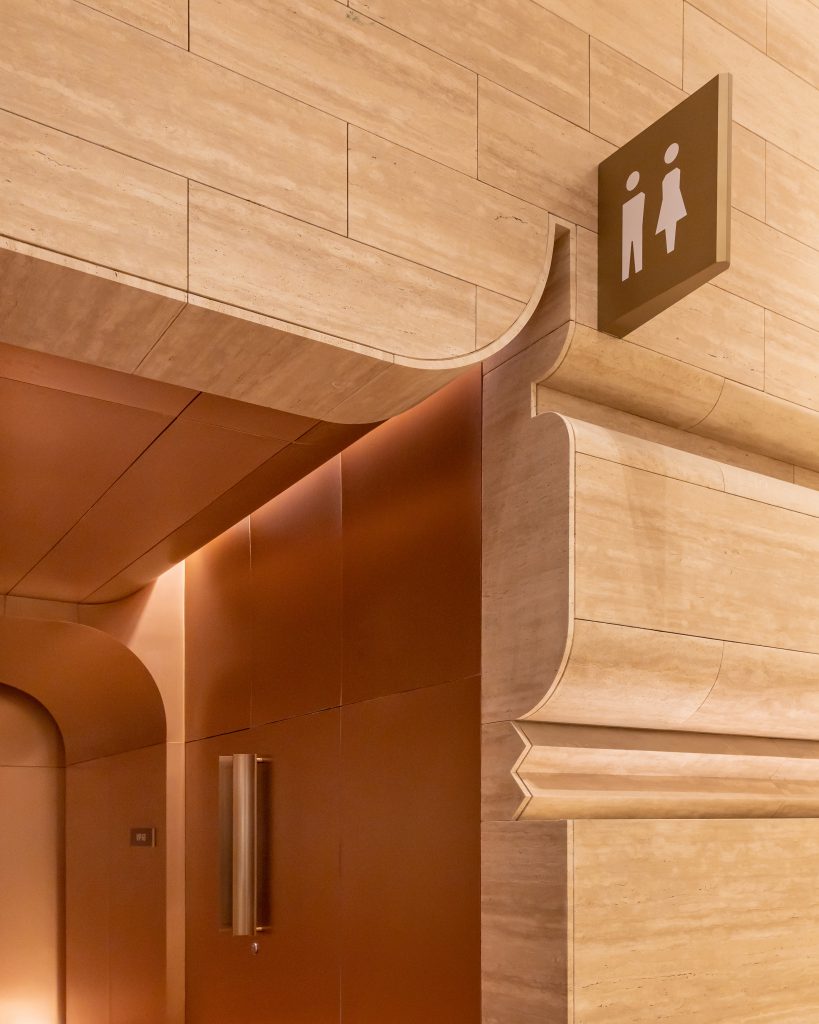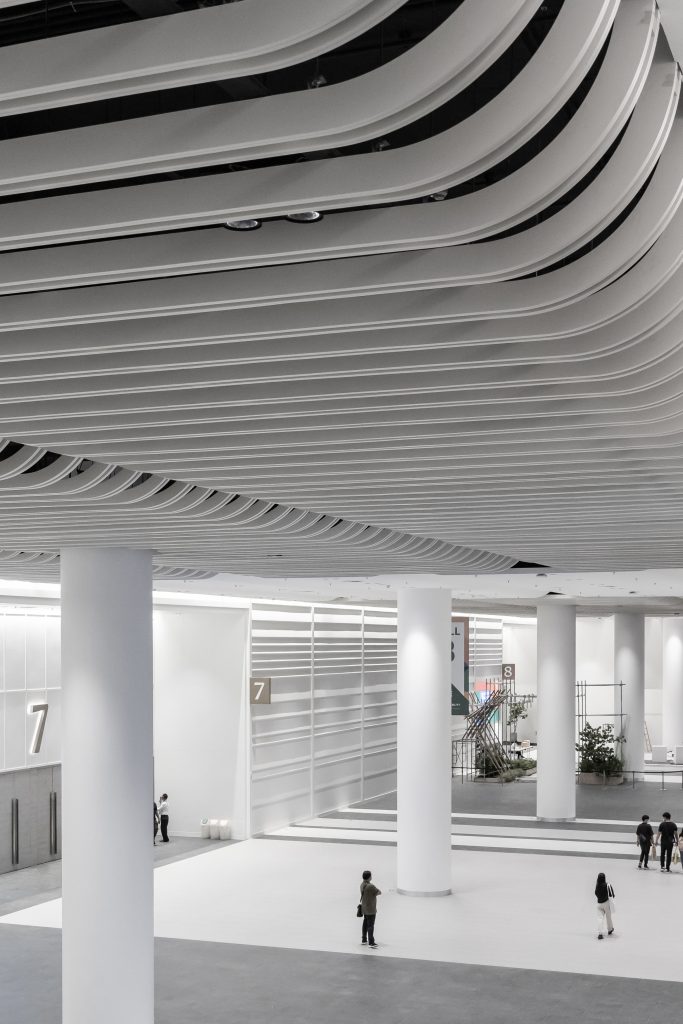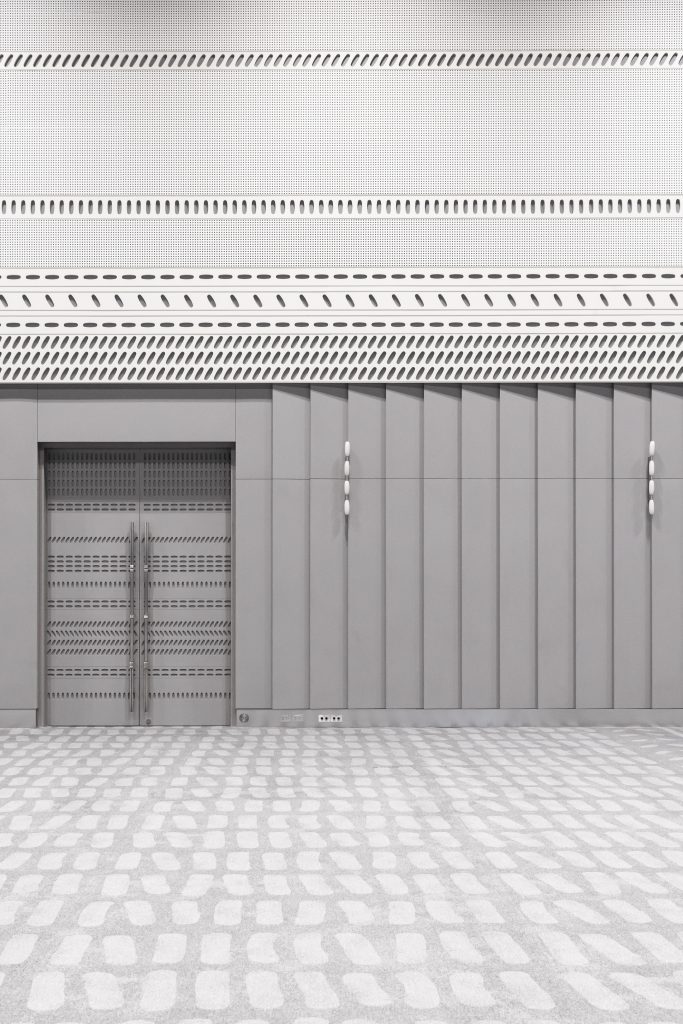The new Queen Sirikit National Convention Center has the architectural form adopting a more muted contemporary language, while the interior architecture themes were drawn from the various looks of the Queen Mother to create the characters for the different areas and functions.
Text: Natre Wannathepsakul
Photo Courtesy of Design 103 international and Ketsiree Wongwan

ดูเหมือนว่าศูนย์การประชุมแห่งชาติสิริกิติ์มักจะมีเหตุให้ต้องใช้ความรวดเร็วการก่อสร้างอยู่ทุกครั้งไป อาคารหลังเดิมมีเวลาก่อสร้างเพียงไม่ถึงปีเพื่อเปิดให้ทันการประชุมสภาผู้ว่าการธนาคารโลกและกองทุนการเงินระหว่างประเทศปี 1991 และในครั้งนี้ก็เพื่อรองรับการเป็นเจ้าภาพการประชุมเอเปค 2022 ผ่านการใช้งานมาสามทศวรรษอาคารหลังเดิมนั้นเริ่มไม่เพียงพอทั้งในด้านขนาดการใช้งาน และความต้องการของการเป็นศูนย์การประชุมแห่งชาติในยุคที่การท่องเที่ยวในรูปแบบ MICE กำลังเติบโตขึ้นเรื่อยๆ และทำให้หลายๆ ประเทศนั้นได้ไล่ตามตลาดที่มีมูลค่ามหาศาลนี้
แม้จะตั้งอยู่บนพื้นที่เดิมซึ่งมีขนาด 53 ไร่ แต่ศูนย์การประชุมแห่งชาติสิริกิติ์แห่งใหม่ ซึ่งใช้ชื่อย่อภาษาอังกฤษว่า “QSNCC” และที่เราเรียกกันติดปากว่า “ศูนย์สิริกิติ์” ได้ขยายขนาดพื้นที่ใช้สอยเป็นห้าเท่าจากเดิมด้วยพื้นที่ใหม่ที่มีขนาดกว่า 300,000 ตร.ม. ฐานอาคารจึงได้ถูกขยายให้ครอบคลุมเนื้อที่เกือบทั้งหมด เพิ่มความสูงจนสุดตามกฎหมายควบคุมอาคาร และทำที่จอดรถไว้ใต้ดิน อาคารหลังใหม่ประกอบด้วยโถงนิทรรศการขนาด 22,000 ตร.ม. สองห้อง ห้องโถงใหญ่ ห้องบอลรูม ห้องประชุมแยกย่อย 50 ห้อง เลานจ์วีไอพี สำนักงานและพื้นที่ค้าปลีกกว่า 13,600 ตร.ม. เส้นทางของยานพาหนะถูกออกแบบให้ล้อมรอบอาคาร โดยมีทางเข้าหลักอยู่ด้านที่หันไปทางสวนป่าเบญจกิติ ส่วนด้านติดถนนรัชดาภิเษกเป็นทางเข้าสำหรับวีไอพี มุมตะวันออกเฉียงใต้เป็นทางเข้าโดยตรงจาก MRT ซึ่งคาดว่าจะเป็นเส้นทางเข้าสู่อาคารโดยผู้ใช้งานมากถึง 70%
การออกแบบสถาปัตยกรรมดำเนินการโดย Design 103 International โดยมี Onion รับผิดชอบด้านการออกแบบภายใน การจัดการภูมิทัศน์โดย shma และป้ายเครื่องหมายและสัญลักษณ์โดย be>our>friend จากบริเวณภายนอกศูนย์การประชุมแห่งใหม่นี้จะปรากฏให้เห็นในลักษณะกล่องกระจกที่มีเส้นสายโค้งมนอย่างนุ่มนวล ซึ่งสื่อเชิงสัญลักษณ์ถึงความอ่อนโยนของสมเด็จพระนางเจ้าสิริกิติ์ฯ ผนังกระจกรอบด้านช่วยเปิดรับแสงสว่างเข้ามายังภายในอาคารได้อย่างเต็มที่ ในขณะที่พื้นผิวภายนอกนั้นจะมันวาวสะท้อนบริบทรอบด้านเป็นการสร้างการเชื่อมโยงกับสภาพแวดล้อมโดยรอบ
ในบริเวณเนื้อที่ซึ่งจำกัดนี้ทำให้เกิดคุณลักษณะอย่างหนึ่งของอาคารขึ้นมา คือการจัดวางโถงนิทรรศการซ้อนชั้นในแนวระนาบและเนื่องจากการจำกัดระดับความสูงทำให้โถงนิทรรศการชั้นล่างนั้นตั้งอยู่ใต้ดิน ซึ่งมักจะเป็นพื้นที่ซึ่งขาดความน่าดึงดูดอยู่ไม่น้อย โดยวิธีการที่สถาปนิกใช้ในการแก้ไขปัญหานี้คือ การสร้างพื้นที่ซึ่งโดดเด่นที่สุดแห่งหนึ่งของอาคารขึ้นมา นั่นคือโถงทางเข้าที่มุมตะวันออกเฉียงเหนือของอาคาร ที่มีผนังกระจกเต็มความสูงพร้อม Feature Stair ที่ทอดยาวจากระดับถนนลดหลั่นลงไปยังบริเวณชั้นล่าง ทำหน้าที่เป็นทั้งทางสัญจรและจุดนัดพบโดยบันไดที่เป็นทั้งทางเดินและที่นั่ง อีกทั้งยังเปิดรับแสงธรรมชาติและทัศนียภาพสู่พื้นที่ใต้ดิน นอกจากนั้นแล้วยังช่วยอำนวยความสะดวกในการอพยพในกรณีฉุกเฉินอีกด้วย

ด้วยระยะเวลาเพียงสามปีในการสร้างอาคาร กระบวนการก่อสร้างที่รวดเร็วจึงเกิดขึ้นได้ด้วยการสร้างแบบจำลองข้อมูลอาคาร (Building Information Model – BIM) และการประกอบชิ้นส่วนสำเร็จรูปมาจากโรงงานของคานเหล็กขนาดใหญ่ (Supertruss) ที่มีช่วงระยะพาดยาวถึง 110 เมตร เหนือห้องโถงนิทรรศการหลักที่ไม่มีเสาเลย คานเหล็กขนาดใหญ่แต่ละอันนั้นจะถูกติดตั้งส่วนของหลังคา งานระบบ ช่องระบายอากาศ และทางเดิน catwalk มาแล้วเสร็จสิ้นจากที่โรงงาน ก่อนขนย้ายไปยังพื้นที่ก่อสร้าง เมื่อไปถึงแล้ว คานเหล็กแต่ละคานจะถูก ‘เลื่อน’ เข้าที่ ซึ่งนับเป็นโครงการแรกในประเทศไทยที่ใช้เทคนิคนี้ และถึงแม้การเลื่อนจะใช้เวลานาน แต่มันสามารถดำเนินการควบคู่ไปกับงานก่อสร้างอื่นๆ ที่อยู่ด้านล่างได้ องค์ประกอบอาคารที่ถือได้ว่าเป็นนวัตกรรมอีกอย่างหนึ่งคือ mullion ที่ผลิตขึ้นพิเศษให้มีลักษณะโค้งเพื่อสร้างเส้นโค้งที่ไร้รอยต่อให้กับส่วน façade ของอาคาร
แต่อะไรคือสิ่งที่จะทำให้ศูนย์การประชุมแห่งชาติสิริกิติ์แห่งใหม่สามารถแข่งขันด้านการท่องเที่ยวรูปแบบ MICE ในระดับภูมิภาคได้? คุณนพดล ตันพิวัฒน์ ซีอีโอของ Design 103 International เชื่อว่าปัจจัยต่อไปนี้เป็นสิ่งที่ทำให้ศูนย์การประชุมแห่งชาติสิริกิติ์โดดเด่นกว่าใคร นั่นก็คือที่ตั้งซึ่งอยู่ในเมืองที่ติดกับสวนสาธารณะที่ใหญ่ที่สุดแห่งหนึ่งในกรุงเทพฯ อีกทั้งอาคารยังถูกออกแบบให้มีความยั่งยืน ความยืดหยุ่น และ Storytelling
โครงการนี้ได้รับการรับรองมาตรฐานอาคารสีเขียวจาก LEED ในระดับเหรียญเงิน โดยได้เลือกใช้วัสดุก่อสร้างที่ประหยัดพลังงานจากการใช้วัสดุรีไซเคิลและพลังงานหมุนเวียนในรูปแบบของแผงโซลาร์เซลล์ โดยจะติดตั้งหลังจากการประชุมเอเปค 2022 ซึ่งจะครอบคลุมพื้นที่กว่า 20,000 ตรม. ของหลังคาและสามารถผลิตไฟฟ้าได้ถึง 2 MWh ความยืดหยุ่นได้แทรกอยู่ในห้องประชุมและพื้นที่จัดแสดงนิทรรศการมากมายที่สามารถรองรับกิจกรรมต่างๆ ได้ตั้งแต่จำนวน 30 คน ถึง 20,000 คน ห้องโถงนิทรรศการ ห้องบอลรูม ห้องโถงใหญ่ และห้องประชุมได้รับการออกแบบมาเพื่อให้สามารถแบ่งออกเป็นห้องเล็กๆ ในรูปแบบต่างๆ ได้ตามต้องการ ห้องประชุมยังมีลักษณะที่แตกต่างกันออกไป ในขณะที่บางห้องเป็นห้องปิดแบบทั่วไป บางห้องเช่นที่ชั้น 1 บริเวณทางด้านทิศเหนือของอาคารเป็นห้องประชุมที่ถูกกั้นด้วยผนังกระจกทำให้สามารถมองเห็นทัศนียภาพของทะเลสาบและให้แสงธรรมชาติสามารถที่จะลอดผ่านเข้าไปยังพื้นที่เลานจ์ที่มีความสูงสองชั้นและตั้งอยู่กลางบริเวณทางเดิน โดยในห้องประชุมสามารถใช้ผ้าม่านเข้ามาช่วยสร้างความเป็นส่วนตัวเมื่อจำเป็น
สิ่งใดก็ตามที่ต่อท้ายด้วยคำว่า “แห่งชาติ” ในชื่อจะต้องคำนึงถึงคำถามเกี่ยวกับเรื่องอัตลักษณ์ของชาติหรือ ‘ความเป็นไทย’ เข้าไปด้วย เช่นเดียวกับอาคารหลังเดิมที่ถูกออกแบบโดย Design 103 International และสร้างขึ้นในช่วงต้นทศวรรษ 1990 คุณนพดลกล่าวว่าในช่วงเวลานั้นประเทศไทยและวัฒนธรรมไทยยังไม่เป็นที่รู้จักอย่างแพร่หลายในเวทีโลก ดังนั้นการออกแบบจึงได้รับแรงบันดาลใจจากความเป็นไทยดั้งเดิม รูปทรงของอาคารเดิมและโครงสร้างทางเข้ารูปหน้าจั่วที่ทับซ้อนกันโดดเด่นได้นำเอารูปแบบบ้านไทยในอดีตมาใช้ และทำให้ดูทันสมัยขึ้นโดยการใช้คานเหล็กขนาดใหญ่สีแดงสด ในขณะที่การออกแบบภายในสะท้อนลักษณะต่างๆ ของเรือนไทยจากภูมิภาคต่างๆ ของประเทศพร้อมกับการเล่นของระดับขั้นบันได ซึ่งการเล่นระดับนั้นอาจจะไม่สอดคล้องกับความต้องการของศูนย์การประชุมนัก ทำให้หนึ่งในปัจจัยในการออกแบบอาคารใหม่นี้คือการสร้างพื้นที่ราบที่จะช่วยเพิ่มความสะดวกในการไหลเวียนอย่างสูงสุดสำหรับทั้งผู้จัดงานและผู้มาเยี่ยมชมงาน
อย่างไรก็ตาม ในช่วงเวลาสามทศวรรษที่ผ่านมาประเทศไทยและวัฒนธรรมไทยได้ถูกเผยแพร่ต่อสายตาชาวโลกผ่านการเติบโตอย่างรวดเร็วของการท่องเที่ยวในบ้านเราและการขยายตัวเพิ่มขึ้นของกระแสโลกาภิวัฒน์ ทำให้การสื่อถึงความเป็นไทยนั้นไม่จำเป็นต้องมีความตรงไปตรงมามากเท่าแต่ก่อน ในคราวนี้แนวคิดในการออกแบบจึงมาจากสมเด็จพระนางเจ้าสิริกิติ์ฯ โดยมีรูปแบบสถาปัตยกรรมที่ใช้ภาษาร่วมสมัยที่เรียบมากกว่าเดิม และปล่อยให้เอกลักษณ์ (ของชาติ) หรือสิ่งที่คุณนพดลเรียกว่า “Storytelling” เป็นหน้าที่ของงานสถาปัตยกรรมภายในโดยการออกแบบของ Onion
“เวลาสมเด็จพระนางเจ้าสิริกิติ์ฯ ไปออกงานที่ต่างประเทศกับในหลวงรัชกาลที่ 9 ท่านก็จะใส่ชุดที่มันดูมีความเป็นไทย แต่ก็ดูมีความเป็นสากลไปพร้อมๆ กัน” คุณอริศรา จักรธรานนท์ ผู้อำนวยการออกแบบและผู้ร่วมก่อตั้ง Onion กล่าว “บางทีชุดและลวดลายก็ไม่ได้ดูไทยนะ ผ้าก็ไม่ได้ไทย แต่พอใส่รายละเอียดเข้าไปแล้วมันดูไทย หรือบางชุดใช้ผ้าไทยแต่ตัดออกมา pattern ฝรั่งหรือจ้างดีไซน์เนอร์ฝรั่งด้วยซ้ำ แต่ก็ดูไทย ท่านเองก็สนับสนุนผ้าไทย ท่านแต่งตัวดีคือเรียกได้ว่า taste ดี เราก็เลยเอาจุดนี้มาเป็นเหมือนภาพหลักที่เราคิดว่าเราอยากจะแตะไปให้ถึง ในแง่ของการออกแบบ” แนวคิดของสถาปัตยกรรมภายในถูกถอดมาจากรูปแบบการแต่งกายที่หลากหลายของสมเด็จพระนางเจ้าสิริกิติ์ฯ เพื่อสร้างลักษณะที่โดดเด่นให้แต่ละพื้นที่และการใช้งาน จากแรงบันดาลใจนี้ การออกแบบพื้นที่ภายในจึงเป็นการสร้างเอกลักษณ์ความเป็นไทยผ่านภาษาการออกแบบที่เป็นร่วมสมัย
ที่ชั้นล่างซึ่งมีทางเข้าจากรถไฟฟ้าใต้ดิน ห้องโถงนิทรรศการชั้นล่าง และพื้นที่ค้าปลีก แนวคิดคือ Casual Thai มีการหยิบลวดลายของผ้าขาวม้ามาใช้เป็นลายบนผนังภายในห้องโถงนิทรรศการและฉากกั้นที่เคลื่อนย้ายได้ เส้นแนวตั้งได้รับการออกแบบให้ช่วยบ่งบอกถึงองค์ประกอบต่างๆ เช่น ทางเข้า-ออก และห้องน้ำ ผนังด้านนอกของโถงนิทรรศการประดับด้วยแผ่นไม้ที่ทับซ้อนกันทั้งแนวตั้งและแนวนอน ทำให้เกิดเส้นเงาคล้ายบ้านไม้พื้นถิ่น แต่ได้ถูกทำให้เป็นนามธรรมและทันสมัยผ่านระยะห่างที่ไม่เท่ากันและการทาสีขาวทั้งหมด

บริเวณชั้นล่างซึ่งมีทางเข้าหลักและจุดรับส่งวีไอพี พร้อมกับห้องโถงนิทรรศการที่ไม่มีเสา ถูกออกแบบภายใต้แนวคิด Formal Thai ในพื้นที่รองรับบริเวณด้านนอกห้องโถงนิทรรศการหลัก ผนังจะหุ้มด้วยหินอ่อนและถูกออกแบบให้ดูเหมือนผนังอาคารโบราณขนาดใหญ่ ชวนให้นึกถึงวัดวาอารามและพระราชวังที่ทรงคุณค่าทางประวัติศาสตร์ ซึ่งขนาดของกระเบื้องหินที่ติดลงบนผนังมีขนาดต่างกันจากตำแหน่งด้านล่างที่มีขนาดใหญ่กว่าตำแหน่งด้านบนที่มีขนาดเล็กลดหลั่นกันไปคล้ายกับในสถาปัตยกรรมคลาสสิกของคฤหาสน์แบบอิตาเลียน ที่ทางเข้าห้องน้ำ ด้านหนึ่งของผนังถูกตัดเป็นลักษณะโค้งซึ่งเป็นความร่วมสมัยที่ถูกแทรกไปกับภาพลักษณ์ดั้งเดิม รวมทั้งทำลายความซ้ำซากจำเจของพื้นที่ค่อนข้างยาวถึง 200 เมตร นอกเหนือจากพื้นแล้วก็ไม่มีระนาบอื่นที่แบนราบอีก เนื่องจากเพดานได้เป็นสันเส้นโค้งเหมือนคลื่นซึ่งปิดด้วยแถบสีทองที่ช่วยขับเน้นเส้นแนวนอนของพื้นที่นี้เข้าไปอีก เสาเป็นทรงหกเหลี่ยม ในขณะที่ผนังกั้นที่ล้อมรอบชุดบันไดเลื่อนจะถูกทาสีทองและฉลุรู ประติมากรรมและงานศิลปะอันโดดเด่นส่วนใหญ่จากอาคารเดิมได้รับการอนุรักษ์และติดตั้งใหม่ในอาคารใหม่ รวมถึงชุดประตูสีทองที่ตกแต่งอย่างวิจิตร ซึ่งปัจจุบันเป็นทางเข้าสำหรับวีไอพีสู่โถงนิทรรศการหลักทางด้านตะวันออกของอาคาร
แนวคิดสำหรับบริเวณชั้นที่หนึ่งและสองคือ Modern Thai ห้องบอลรูมได้รับแรงบันดาลใจมาจากผ้าของชาวเขา ซึ่งถูกทำให้เรียบง่ายและจัดเรียงรูปแบบใหม่โดยนักออกแบบ และนำไปใช้ทั่วบริเวณห้องบอลรูม เช่น ลายการเจาะที่ประตู รูปแบบของที่จับประตู แถบเจาะรูบนผนัง เช่นเดียวกันกับลวดลายพรมและแม้กระทั่งรูปทรงของโคมไฟ ผนังด้านนอกของห้องบอลรูมให้บรรยากาศแบบอุตสาหกรรม จากระยะไกล พื้นผิวดูคล้ายเหล็กชุบสังกะสี เมื่อเข้าใกล้จึงจะเห็นว่ามันคือเปลวเงินที่ถูกค่อยๆ ลงมือแปะลงทีละเล็กทีละน้อยอย่างประณีต การใช้วัสดุเพียงชนิดเดียวบนพื้นผิวขนาดใหญ่ดูจะเป็นหนึ่งในแนวทางการออกแบบที่พบเห็นได้บ่อยๆ ในงานของ Onion และการถูกนำมาใช้ที่นี่ก็ให้ผลลัพธ์ที่ยอดเยี่ยมอีกครั้ง
ห้องโถงใหญ่หรือเพลนารีฮอลล์ พร้อมกับวิวทะเลสาบและสวนสาธารณะ ถูกออกแบบให้เป็นพื้นที่ที่ดูสง่างามที่สุดโดยได้รับแรงบันดาลใจจากชุดไทยและลายประจำยาม พื้นที่รองรับเป็นพื้นที่โถงสูงสองชั้น มีเสาล้อมรอบและทุกพื้นผิวถูกปูด้วยหินทรายโดยมีบันไดขนาดใหญ่เป็นจุดศูนย์กลาง ให้กลิ่นอายของงานของ David Chipperfield ในขณะที่ห้องโถงใหญ่ทั้งหมดถูกประดับด้วยลวดลายประจำยามซึ่งถูกลดทอนให้เรียบง่ายและใช้ทั่วทั้งอาคาร เป็นเสมือนลวดลายต้นแบบ โดยในพื้นที่นี้ถูกนำไปใช้กับมือจับประตู ลายพรม แผงกันเสียงบนเพดาน และยืดขยายใหญ่เป็นรูปทรงของกำแพงบางส่วนที่ยื่นออกมา มีการจัดไฟไว้ด้านหลังและแต่ละส่วนมีความหนาและวัสดุปิดผิวที่ต่างกันไป ความรู้สึกของความหรูหราแต่เรียบง่ายนี้ เกิดขึ้นจากการมีพื้นผิวที่ดูเสมือนเรียบๆ แต่กลับมีการใช้วัสดุที่หลากหลาย ในบริเวณที่มีผนังกระจกแผ่นฝ้าเพดานมีพื้นผิวเป็นโลหะแตกต่างไปจากส่วนอื่นของห้อง พื้นที่ส่วนนี้สามารถกั้นให้ทำหน้าที่เป็นพื้นที่รองรับ แยกเป็นพื้นที่โถงใหญ่อีกห้อง หรือใช้เป็นทางเดินเมื่อห้องโถงใหญ่ถูกซอยแบ่งเป็นห้องขนาดเล็ก องค์ประกอบของลายประจำยามจะค่อยๆ ลดขนาดลงจากด้านในสู่ด้านนอก ส่วนอื่นๆ ในอาคารที่ใช้ลายประจำยามก็จะมีผนังฉลุลายที่ล้อมรอบแกนบันไดเลื่อนหน้าห้องโถงนิทรรศการหลัก และแผงโซลาร์เซลล์บนหลังคาจะถูกติดตั้งเป็นลวดลายนี้เช่นกัน ซึ่งสถาปนิกกล่าวว่าจะมองเห็นได้เมื่อดูใน Google Earth
บททดสอบความสำเร็จของ QSNCC แห่งใหม่ที่แท้จริงคือเมื่อฝูงชนหลั่งไหลเข้ามา ด้วยจำนวนผู้เข้าใช้งานมากกว่า 100,000 คนต่อวันในช่วงกิจกรรมยอดนิยม เช่น งานเทศกาลหนังสือ การหมุนเวียนที่มีประสิทธิภาพสำหรับทั้งผู้เข้าใช้งานและผู้จัดงานจะมีความสำคัญมาก เพื่อให้แน่ใจได้ว่าผู้คนจะไหลเวียนไปทั่วอาคารอย่างราบรื่น ทีมออกแบบจึงให้ความสำคัญกับบันไดเลื่อนแทนลิฟต์ และสร้างการแบ่งแยกที่ชัดเจนระหว่างเส้นทางของส่วนหลังบ้านกับการเข้าถึงของผู้มาชมงาน สิ่งที่สำคัญไม่แพ้กันสำหรับผู้มาใช้อาคารก็คือการรู้ถึงทิศทางเมื่อพวกเขาอยู่ภายในอาคารขนาดใหญ่เช่นนี้ นอกเหนือจากป้ายแล้ว ทางเดินที่เป็นแนวตรงรวมกับ façade ที่เป็นกระจกทั้งหมดซึ่งมากับวิวภายนอกของอาคารที่โดดเด่นในละแวกนั้น ล้วนเป็นสิ่งที่จะช่วยให้ผู้คนไม่หลงทาง นอกจากนี้ แกนบันไดเลื่อนหลักสามแกนยังมีการใช้สีที่ต่างกันคือบรอนซ์ เงิน และทอง เพื่อให้แยกแยะกันได้อีกด้วย
การออกแบบสถาปัตยกรรมพยายามเน้นความไม่อิงต่อยุคสมัย ซึ่งในความรู้สึกแรกอาจดูเรียบจนเกินไป แต่หลังจากยุคของ Bilbao Effect และการมีอาคารที่มีรูปทรงเชิงสัญลักษณ์มากมายที่เราได้เห็นกันเมื่ออัตลักษณ์ประจำชาติถูกเรียกหาบางทีอาคารที่รูปลักษณ์ไม่โดดเด่นจนเกินไป แต่เต็มไปด้วยรายละเอียดที่น่าจดจำและความสง่างามที่เรียบง่าย อาจจะเหมาะสมแล้วในการบรรเทาความวุ่นวายของเมืองหลวงแห่งนี้ การตกแต่งภายในแสดงถึงความเป็นงานออกแบบร่วมสมัยและความเป็นสากลอย่างชัดเจน และดูเหมือนว่าจะสามารถสร้างความสมดุลระหว่างการทำให้ตัวพื้นที่มีความพิเศษและน่าสนใจ แต่ก็ไม่มากเกินไปจนเป็นการแข่งขันกับงานต่างๆ ที่จะมาจัดแสดง และท้ายที่สุด คงต้องให้เครดิตกับ Thai Obayashi ไม่น้อยสำหรับคุณภาพของงานก่อสร้าง เนื่องจาก “พระเจ้าอยู่ในรายละเอียด” และเพราะได้รับการสร้างมาอย่างดี อาคารหลังนี้จึงมีรายละเอียดมากมายรอให้ชาวโลกได้มาชื่นชม

The construction of the Queen Sirikit National Convention Center has always been about speed. With the former building, it had less than a year to build in order to open in time for the annual meetings of the Boards of Governors of the World Bank Group in 1991, this time, it is in order to host APEC 2022. After three decades, the original premises had become inadequate both in size and functionality for the scope and ambitions of a national convention center in a world where the rise of MICE travel has got many a nation chasing after this lucrative market.
Although situated on the same 85,000 sqm (53-rai) site, the new Queen Sirikit National Convention Center, abbreviated as QSNCC and known colloquially as the “Sirikit Center,” has been enlarged to five times the size of its predecessor to a total floor area of 300,000 sqm. In doing so, the building has swelled to cover the whole site, pulled up to its height limit and sunk the parking underground. It now contains two 22,000 sqm exhibition halls, a plenary hall, a ballroom, 50 break-out meeting rooms, VIP lounges, offices, and 13,600 sqm of retail space. Vehicular circulation encircles the building with the main entrance aligned to the side facing the Benchakitti Forest Park, while the side abutting Ratchadaphisek Road is allocated as VIP access. The southeast corner has direct access from the MRT, where it is expected that up to 70% of visitors will access the building.
The architecture design is by Design 103 International, with the interior design by Onion, landscaping by shma, and signage by be>our>friend. From the outside, the new convention center appears as a gently undulating glass box, its supple lines a symbol for the grace of Queen Mother Sirikit. The glass curtain wall lets in ample daylight into the interior, while outside its slick surface reflect – and in doing so, establish a connection with – its surroundings.
On such a limited site area, one of the building’s features is the vertical stacking of the exhibition halls. Due to the height limit, this meant that most of the lower exhibition hall in fact lies underground, which do not often make for the most attractive of spaces. The way in which the architects resolved this issue is by creating one of the building’s most prominent spaces: a full height glazed atrium with a feature stair leading from the street on the northeast corner of the site down to the lower ground floor. It acts as a pedestrian access and meeting point with the stairway doubling as seating, brings in daylight and views into the underground space, and facilitates emergency evacuation.

With just three years to build, the rapid construction process was made possible by BIM and the prefabrication of the steel supertrusses that span 110 meters over the column-less main exhibition hall. Each supertruss is completely outfitted with its own roof section, electrical systems, air vents, and catwalk at the factory before being transported to the site, once there, each truss is ‘slide’ in, the first project in Thailand to employ such technique, and although this is a time-consuming process, it could be done in parallel with other construction works underneath. Another innovative component is the mullions, which have been custom-made with a curved profile to create the seamless curvilinear contour of the exterior façade.
But what is it that will allow the new QSNCC to compete in MICE tourism on a regional level? Noppadon Tanpiwat, CEO of Design 103 International, contends that the following factors are what make the QSNCC stands out from the crowd: its inner-city location bordering Bangkok’s largest park, sustainability, flexibility, and storytelling.
Certified LEED Silver, the project makes use of energy-efficient building materials with recycled content as well as renewable energy in the form of solar panels. The latter will be installed after APEC 2022, will cover more than 20,000 sqm. of the roof, and be able to generate up to 2 MWh. Flexibility lies in the abundance of meeting rooms and exhibition spaces that can cater to events ranging in capacity from 30 to 20,000 people. The exhibition halls, ballroom, plenary hall and meeting rooms have been designed to be able to divide into smaller units in a variety of configurations as the need arises. The meeting rooms also vary in character, while some are the typical closed rooms, some such as those on Level 1 on the northern side of the building are glass enclosures that allow for generous views of the lake, as well as for natural light to penetrate into the double-height lounge areas located along the corridor. Curtains ensure privacy when required.

Anything with “national” in its name is bound to have to reckon with the question of national identity or “Thainess.” This was true of the former building, conceived and built in the early 1990s. According to Tanpiwat, this was a time when Thailand and Thai culture was not as widely known on the world stage, so its design, also by Design 103 International, was more traditional in its inspiration. The original building’s form and distinctive overlapping gable-shaped entrance structure, though modern through the use of bright red steel trusses, were taking its cue from the form of the traditional Thai house, while the interior design reflected the various characteristics of traditional houses from the country’s different regions, together with the play of stepped levels. The last proved to be functionally misaligned to the needs of a convention center, and one of the design considerations for the new building was to create level planes that would maximize ease of circulation for both the event organizers and visitors alike.
The last three decades, though, have brought Thailand much exposure internationally with the boom in tourism and the acceleration of globalization in general, meaning that the cultural references no longer have to be so explicit. This time around, the design concept is drawn from the building’s namesake Queen Mother Sirikit, with the architectural form adopting a far more muted contemporary language, leaving much of the expression of (national) identity, or what Tanpiwat calls “storytelling” to the interior by design practice Onion.
“When Queen Mother Sirikit would go on international tours with the late King Rama IX, she would always wear something that looked Thai, but also modern at the same time,” says Arisara Chaktranon, design director and co-founder of Onion. “Sometimes, the pattern or the textile were not Thai, but put together with certain details, they somehow appear Thai, or using Thai textiles but using western cuts or dressmakers. She was a great supporter of Thai textiles. She always dressed well, which is to say that she had great taste. Her image is what we are striving towards.” Interior architecture themes were drawn from the various looks of the Queen Mother to create the characters for the different areas and functions. Taking cue from their inspiration, the design is a balancing act between traditional Thai references rendered in a contemporary design language.
On the lower ground floor, where there is the entrance from the MRT, the lower of the exhibition halls and retail space, the concept is casual Thai, referencing the plaid pattern found on the traditional multipurpose loincloth known as “pha khao ma.” The pattern appears on the interior walls and movable partitions of the lower exhibition hall, the vertical lines of the pattern are designed to function as signposts for elements such as doorways and bathrooms. The outside walls of the exhibition hall have overlapping boards, both vertical and horizontal, creating shadow lines that seem to recall vernacular timber houses, but which have been abstracted and modernized through uneven spacing and being rendered in white.
On the ground floor, which is where the main entrance as well as VIP drop-off are located, together with the main column-free exhibition and convention hall, the concept is formal Thai. In the pre-function area outside the main exhibition hall, the walls are clad in travertine and designed to appear like an outsized monolithic wall with mouldings that are abstract yet evokes the image of historical temples and palaces. The size of the stone tiles diminishes the higher up they are like in the classical architecture of Italian palazzi. Where the wall breaks for bathroom entrances, one side of the wall tapers in a curved line – a contemporary flourish to offset the traditional image as well as to break the monotony of the very long 200-meter space. Aside from the floor, there isn’t another straight (forward) plane, the ceiling has curved ridges like upturned waves capped with golden bands that further stresses the horizontality of this space. The columns are hexagonal, while the partition screens enclosing the escalator cores are painted gold and perforated. Most of the iconic sculptures and artworks from the former building have been preserved and reinstalled in the new building, including the ornately decorated gold doors that now act as the VIP entrance into the main exhibition hall on the east side of the building.
The concept for the first and second levels is modern Thai. With the ballroom, the inspiration came from the textile patterns of the northern tribespeople, simplified and rearranged by the designers and applied all across the ballroom area: as perforations on the doors, the form of the door handles, in perforated bands across the walls, as the carpet pattern, and even as the form of the lighting fixtures. The external walls of the ballroom appear industrial from afar, its surface looking almost like galvanized steel, which then transforms into consummate craftsmanship up close when you realise that it is actually imitation silver leaf, painstakingly applied by hand bit by bit. Utilizing a single material across a vast expanse of surface is becoming one of the trademarks of Onion’s designs, and it has once again been deployed here to great effect.
The plenary hall – with a grand view of the lake and park – aims to have the most elegant look of all, drawing inspiration from traditional Thai formal dresses and the Pra Jam Yam motif (a Thai pattern design of a flower with four leaves). The prefunction area is a Chipperfieldian colonnaded double-height space clad entirely in sandstone, with an ascetic grand staircase as its centerpiece. The plenary hall itself is all about the Pra Jam Yam motif, which has been simplified and used throughout the building as a kind of master motif. Here it is applied to the door handles, the carpet pattern, the acoustic panels on the ceilings, and stretched out of proportions into backlit wall sections of different thicknesses and finishes. The sense of understated elegance is created through the seemingly plain surfaces that in fact contain a richness of varying material textures. The area enclosed by the glass curtain wall has a different metallic finish for the ceiling panels and can be closed off to act as a pre-function area, a separate plenary space, or as a corridor for when the plenary hall is divided into smaller spaces. The Pra Jam Yam elements diminish in scale the closer they get to the curtain wall. Elsewhere in the building, the motif is applied to the perforated screens enclosing the escalator cores in front of the main exhibition hall and the solar panels on the roof will be installed to this pattern, which the architect says will be visible when viewed on Google Earth.
How the building copes once the crowd descends will be the true test of the success of the new QSNCC. With more than 100,000 visitors per day during popular events such as the annual book fairs, effective circulation for both visitors and event organizers will be crucial. To ensure a frictionless flow of people through the building, the designers prioritize escalators instead of elevators and creating a clear separation between service and visitor access. Equally important for visitors is having a sense of direction when they are inside such a large building; aside from the signage, the straight corridors combined with fully glazed façades with outside views, particularly of distinctive buildings in the neighborhood, are helpful for visitors to orient themselves. In addition, the three main escalator cores are color coded in bronze, silver, and gold.
The architectural design is a stab at a sense of timelessness, which might at first appear too subdued, yet after the formal bombast of the Bilbao Effect era and the many all-too-literal symbolic buildings that we have been blessed with when national identity is called for, maybe an unassuming building filled with delightful details and quiet elegance is just the kind of antidote our chaotic urban fabric needs. The interior displays a sensibility that is very much attuned to the international design zeitgeist and does indeed seem to have strike that very fine balance between being interesting, yet also pared down enough to act as backdrop and not compete for too much attention. Much credit must also be given to Thai Obayashi for the superb quality of the construction work, since God is in the details and because they have been so well-made, there will be plenty here for the world to marvel at.

อ่านบทความคอลัมน์อื่นๆ หรือดาวน์โหลดเล่มวารสารฉบับออนไลน์ 09 Metal Attraction คลิกได้ที่นี่







